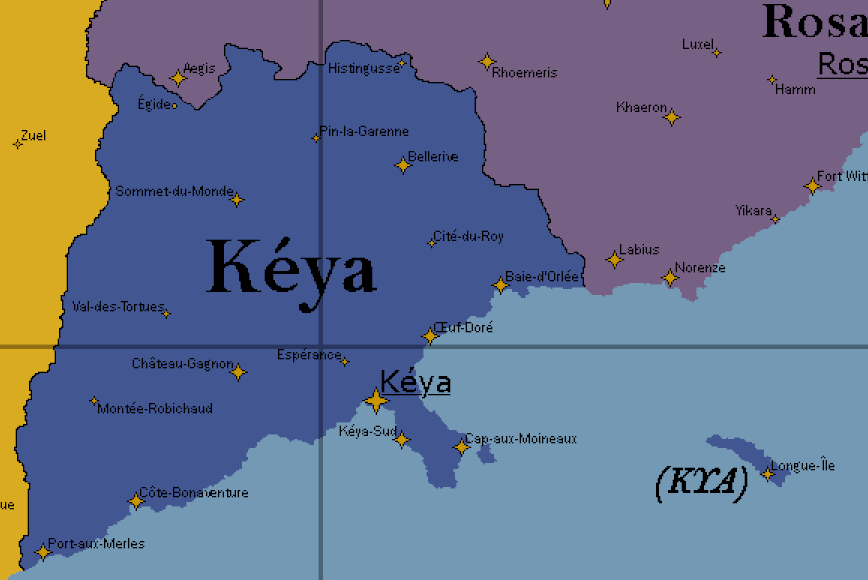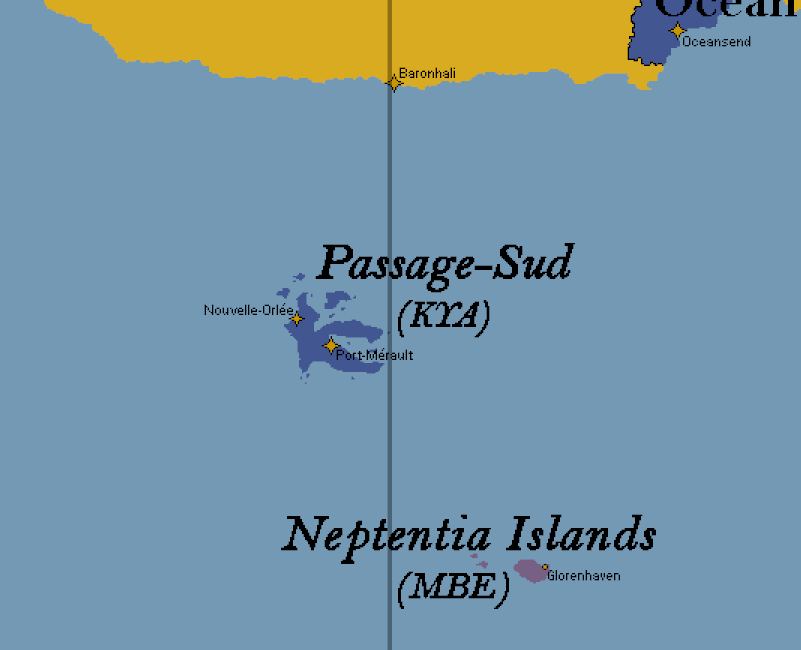Flag: I will probably reuse the Aponivian flag (maybe with different colours) if no one objects (would work well because the mountains are very important to Kéyanese history)
Nation Name (long): Grande-Kéya (mostly used for mainland + holdings)
Nation Name (short): Kéya (mostly used for mainland)
Motto: “Sous l’œil des montagnes, l’éternité nous viendra.” (Roughly: “Under the protection of the mountains, eternity will come to us.”)
National Animal: Chamois
National Flower/Plant:Clematis viticella
National Anthem:Glorieuse Kéya
Capitol: Kéya
Largest City: Kéya
Demonym: Kéyanese, Kéyan (Kéyanois/e)
Language: Lissian
Species: Cava (mostly)
Population: 63,000,000
Government type: Republic
Leader(s): Arrabelle Baudin, Présidente de la République
Legislature: (unicameral) Assemblée populaire
Formation: Not precisely determined yet, see history
Total GDP: 1.575T
GDP per capita: 25k
Currency: Kirib, assuming UNAC membership (otherwise, the Lis)
STATS JUSTIFICATION: Stats are based on a seriously downgraded Metropolitan France even though it’s only 50,000 sqkm smaller. While probably higher than usual, I feel that this is necessary for an Auroran nation of its size.
Calling Code: TBD (i wanna see what Aurora does for calling codes)
ISO 3166 code: KYA
Internet TLD: .kya
Historical Summary:
This will obviously all be tweaked and adjusted to slot it into Auroran history.
The proto-Kéyanese people lived mostly in what is today the northern part of the country. Dotted around the mountains and northern plains, these people eventually formed small kingdoms and principalities. South of them, occupying a sizable portion of the plains and the whole coastline were the Imbiraturian people, which expanded into an empire occupying all but the aforementioned northern parts of modern-day Kéya. Their focus was mainly on trade, and they would eventually reach as far as Maladh Al-Taajir around 300 BCE (Imbiraturia founded Al-Taajir). Long before that, the Kéyanese kingdoms became subjects of the Imbiraturians. The princes could continue ruling their territories as long as they swore loyalty to the emperor and paid their taxes, which was mainly why Imbiraturia took interest in the small northern kingdoms in the first place.
Eventually, the Imbiraturian Empire began to decline due to both internal and external pressures. They were no doubt still a prosperous realm from a civilian perspective, though multiple difficult wars and a succession crisis weakened the state. Sensing an opportunity in the instability, the Kéyanese kingdoms began to rebel. The Imbiraturians were still capable of crushing these even in their weakened state. That was, until the largest of the kingdoms (yet unnamed) triumphed over their overlords in battle. This boosted the confidence of the Kéyanese kingdoms who proceeded to unite under one banner and conquer the whole of the empire over the course of a few centuries. When the Imbiraturians were defeated, the unified Kéyanese kingdom had borders similar to the modern ones. They also inherited the Imbiraturian outposts that eventually became Longue-île, Passage-Sud, and Tempête-Éternelle, though these have had periods of ownership from entities other than Kéya since then.
Unfortunately, I’m not very familiar with the Middle Ages in Aurora, so I’ll have to work with those peeps to figure this part out. Overall though, the Kingdom of Kéya continues to grow (as in population and economically) and eventually ends up claiming the islands of Belle-Fortune. Also, it’s during this period that the seigneurial (lord) system is established, which will eventually lead to the modern internal divisions of Kéya.
The early modern period probably saw some sort of cultural revolution within the kingdom, and this is probably when what remained for Imbiraturian architecture was destroyed or dismantled.
In the 1800s, some reforms were passed, bringing Kéya closer to a constitutional monarchy. In the 1900s, the entire royal family was assassinated and the first democratic government was installed and failed (the people deemed them to be too violent, and so rather ironically killed the first government). Having no obvious line of succession for royalty, a second democratic government was put into power shortly after, which is more or less the same institution it is in the modern day.
Kéyanese involvement in the Great War and Auroran-Cerenerian War needs to be determined, though it probably stayed neutral during the former and joined the Bursil Alliance during the latter (probably to avoid getting obliterated by its two much larger neighbours).
In the modern day, Kéya is a proud, prosperous, and democratic nation that will hopefully be a part of the UNAC. I look forward to working on mainland Aurora ![]()

